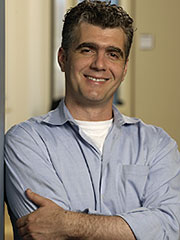Algae system transforms greenhouse emissions into green fuel
The story gets even better. Algae double in mass every couple of hours, so they can be harvested and easily converted into biodiesel, a clean, storable fuel to use in the power plant or a diesel vehicle. Of course, burning the algae releases the carbon they captured from the flue gases. “All the original carbon will ultimately reach the environment, but you’ll have run the vehicle as well as the power plant,” said Berzin. “Put simply, you’ve created two amounts of energy with one amount of pollution.”
Using algae to capture CO2 isn’t a new idea, but no one has found a commercially viable method of doing it. What’s Berzin’s secret? “We give an old idea a push with technology,” he explained.
For example, Berzin and his coworkers “tailor” algae to perform well at a specific power plant. They use a terrestrial cousin of a miniature bioreactor designed for the International Space Station. As algae grow inside the bioreactor, their environment is gradually shifted to conditions they will encounter at the plant. Within three months, the tailored algae are thriving on flue gases instead of air. No genetic engineering is involved. “We just use the natural tendency of algae to adapt to any environment,” said Berzin.
In fall 2005, the algae system was installed at a 1000-MW power plant in the Southwest. Initial field trials at the plant were successful, and testing is now moving into a pilot phase. Berzin estimates that more than 1000 power plants in the United States have enough flue gas, water, and land to host a commercial-scale installation. Many other industrial facilities would no doubt also qualify.


